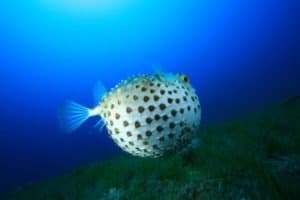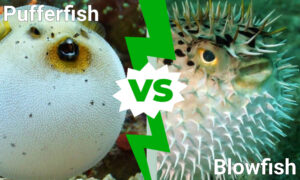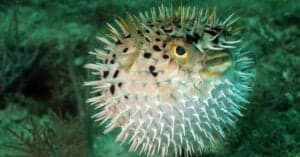Pufferfish are fish found in freshwater and saltwater around the world. They are best known for their defensive capabilities that include using water to inflate their bodies as well as the deadly toxin present in some species. When fully inflated, these fish can look downright dangerous, but they spend most of their time looking meek. What do the pufferfish eat? Also, are they as alarming as they look?
We’ll show you the different foods pufferfish eat as well as why they pose a risk to humans. These interesting fish have many facets worth exploring.
What Foods Do Pufferfish Eat?
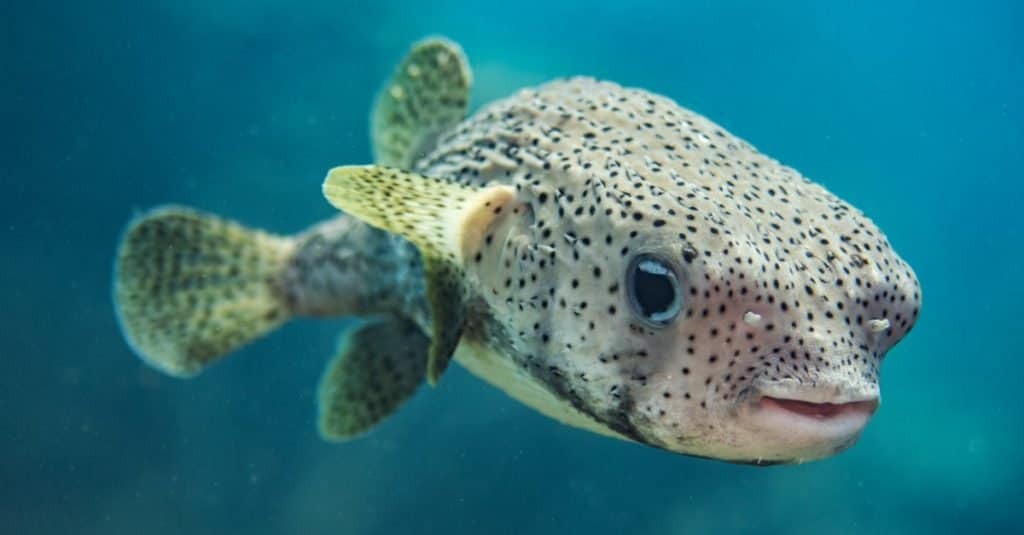
Pufferfish eat other fish, algae, and shellfish.
©J.T. Lewis/Shutterstock.com
Pufferfish eat mollusks, algae, small invertebrates, and other fish. They are omnivores that consume a variety of foods depending on their location. Most pufferfish live in temperate or tropical waters around the world, and some species have access to certain creatures that others do not.
As such, some pufferfish can be nearly herbivorous while others are mostly carnivores. These are the foods that pufferfish will commonly eat:
Their access to these foods can be limited by location, but pufferfish will rarely pass up a good meal including any of these items. Pufferfish are frequently said to eat anything they can fit in their mouths. While that may be especially true in captivity, the aforementioned foods are commonly eaten in the wild.
When living in the wild, a pufferfish’s diet is more significant than satisfying its hunger. The foods they eat provide them with the bacteria needed to create the tetrodotoxin that makes them so deadly to most other living creatures. If a pufferfish is bred and raised in captivity and has its diet controlled, it lacks this toxin.
Nevertheless, the pufferfish’s diet is very important to their biology, especially if they want to remain safe from predators.
How Do Pufferfish Hunt?
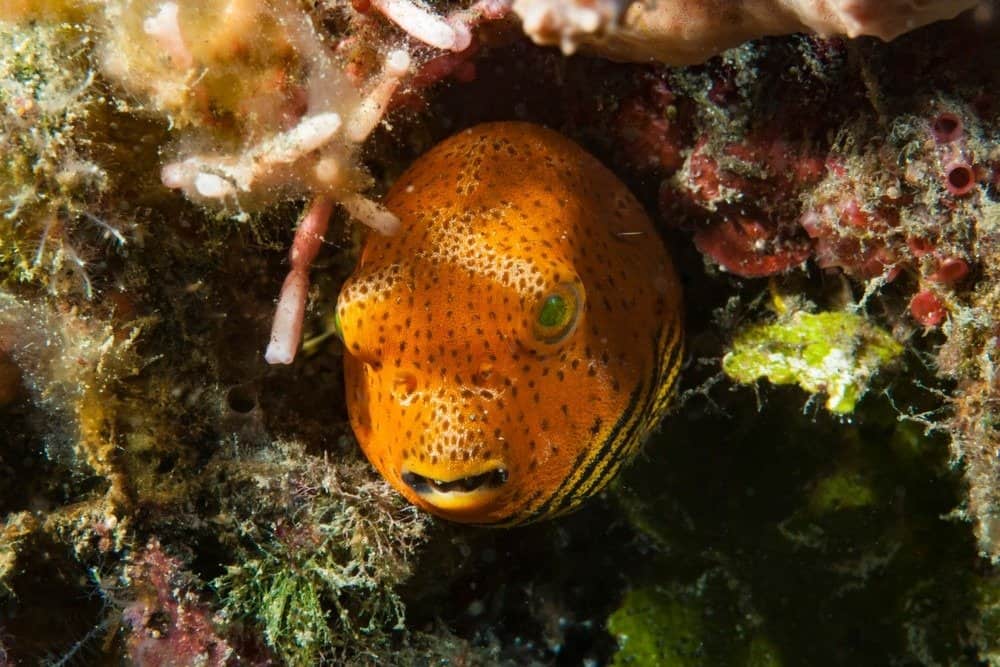
Pufferfish will often wait for food to swim by and then ambush it.
©Francesco_Ricciardi/Shutterstock.com
Although pufferfish have a very strong toxin in their system, they cannot use it like snakes where they bite their prey, and they can wait for it to die. Instead, pufferfish have several methods of hunting that are frequently utilized when looking for food.
The easiest way for pufferfish to get a meal is to simply eat algae while they are swimming in the ocean water. However, if they are going after prey, they will either use stealth to swim near a fish and strike, or they will lie in wait somewhere they can set up an ambush.
Pufferfish are fans of shellfish and mollusks, so they will frequently find these creatures and crack open their shells with their teeth and eat them. Pufferfish teeth are unique in that they are fused together and form a beak-like structure that helps them eat hard-shelled creatures. In some cases, these teeth never stop growing.
Pufferfish are effective hunters even though they lack strong swimming abilities. They can manifest quick bursts of speed that help them catch prey.
What Do Pet Pufferfish Eat?
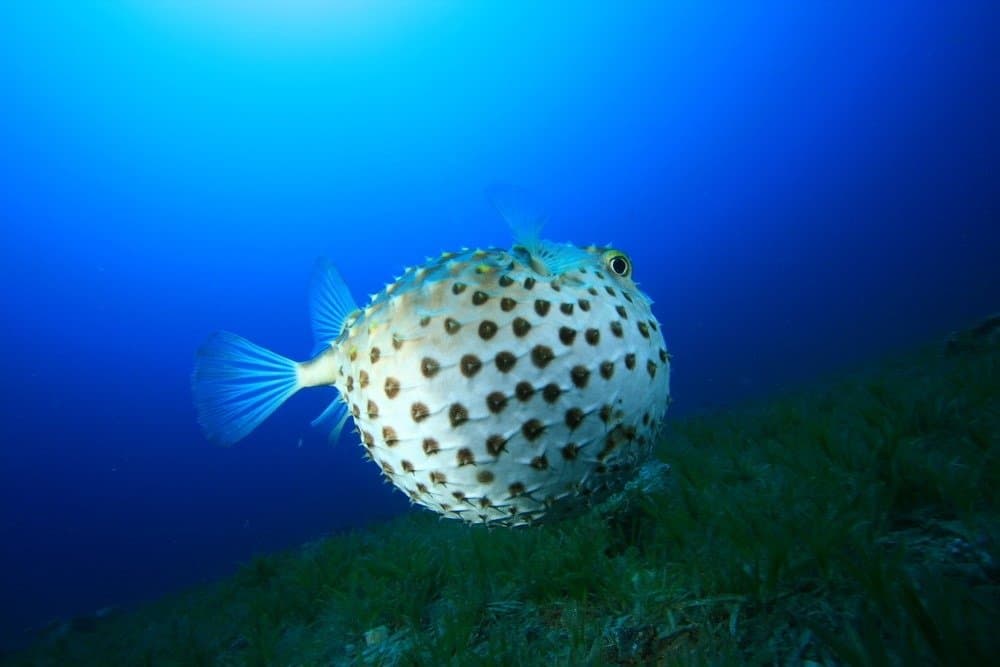
Pet pufferfish eat shrimp, clams, and algae wafers
©Rich Carey/Shutterstock.com
After reading the section about pufferfish finding food and having a very powerful toxin, you might not want to put one in an aquarium in your home. However, many pufferfish species exist, including freshwater variants, and you can keep them as pets if you’re willing to work hard at maintaining them.
As a caution, you should always get as much information about your particular species before you decide to purchase a pet. That way, you know what danger the fish poses to you and how to keep it happy.
Once you have obtained a pufferfish, you need to keep them well-fed. These are the foods that pet pufferfish eat:
- Various whitebait fish
- Bloodworms
- Commercial pufferfish food
- Chopped squid
- Algae wafers
- Clams
- Krill
- Shrimp
- Aquatic snails
- Coral
Even though you can supplement their meals with commercial fish food, pufferfish can be expensive to keep as they need food with hard shells to keep their teeth strong and prefer to eat somewhat fresh foods. These are high-maintenance creatures that are a lot harder to care for than a goldfish.
What Predators Hunt Pufferfish?
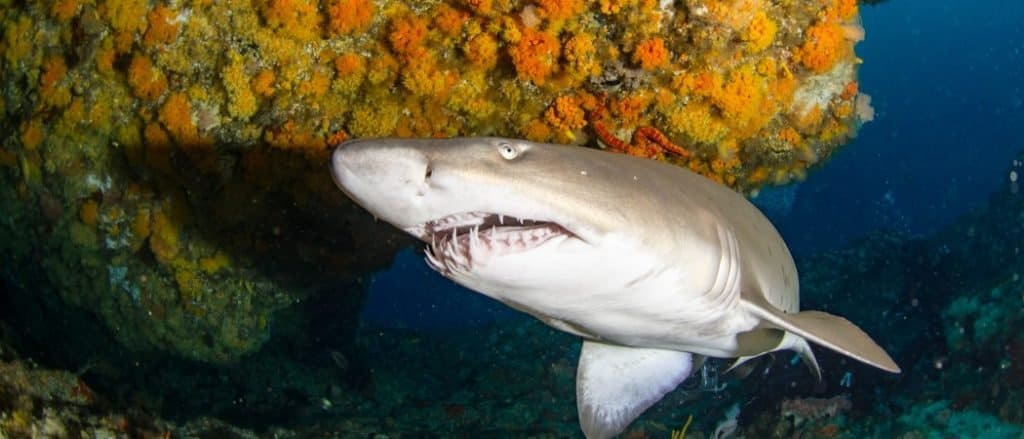
Tiger
sharks frequently eat pufferfish.
©Stefan Pircher/Shutterstock.com
Although the pufferfish has a powerful toxin in its skin, spikes, and organs, that does not deter every predator. Some creatures are just looking for a good meal and hope to take this one by surprise. The slow swimming exhibited by pufferfish and their willingness to swim in the open makes them targets.
Some of the most common predators of pufferfish are:
- Tiger sharks
- Sea snakes
- Humans
Several types of sharks and sea snakes are almost immune to the toxin from pufferfish. Sharks can eat the pufferfish without fear of dying in most cases. Meanwhile, dolphins have been witnessed using contact with the pufferfish to willfully enter a trance-like state for a time.
Sometimes, other predators believe they have made a meal of a pufferfish, only for them to suffer from the tetrodotoxin or choke from a fish that suddenly inflates inside of them.
Needless to say, pufferfish do not have many successful predators in the wild. Humans do fish and eat pufferfish, but that is not without danger.
Are Pufferfish Dangerous to Humans?

Pufferfish can be extremely dangerous to humans. Their tetrodotoxin can quickly be fatal. However, pufferfish is also a food named ‘fugu’ that’s consumed in some cultures.
Pufferfish can pose a danger to humans in two different ways: when humans touch pufferfish in the wild or when they’re inadvertently caught in fishing nets, the tetrodotoxin can be fatal. The toxin in a single pufferfish is enough to kill a human being several times over.
Adventurous humans also enjoy eating pufferfish as well. However, they eat the less toxic varieties and only go to specially trained chefs to obtain the food. The flesh of the pufferfish does not contain the toxin, only the skin, spikes, and organs.
The dish, called fugu, is properly prepared when it causes tingling or numbness in the lips. When not prepared correctly, it can kill the consumer. This happens about half a dozen times per year.
Pufferfish are omnivores that make for surprisingly effective hunters. Despite their slow swimming pace, they are capable ambush predators and have the power to crack open animals with hard shells.
The pufferfish make a delectable meal for some humans, but they can also spell trouble for them as well as other would-be predators. The pufferfish’s ability to inflate their bodies along with their potent toxins keep them relatively safe from harm.
Summary of 12 Favorite Foods of the Pufferfish
| Favorite Food | |
|---|---|
| 1 | Coral |
| 2 | Sea Sponges |
| 3 | Algae |
| 4 | Flatworms & Bloodworms |
| 5 | Shrimp |
| 6 | Crab |
| 7 | Mussels |
| 8 | Oysters |
| 9 | Crawfish |
| 10 | Snails |
| 11 | Krill |
| 12 | Lancetfish |
The photo featured at the top of this post is © iStock.com/FtLaudGirl
Thank you for reading! Have some feedback for us? Contact the AZ Animals editorial team.



